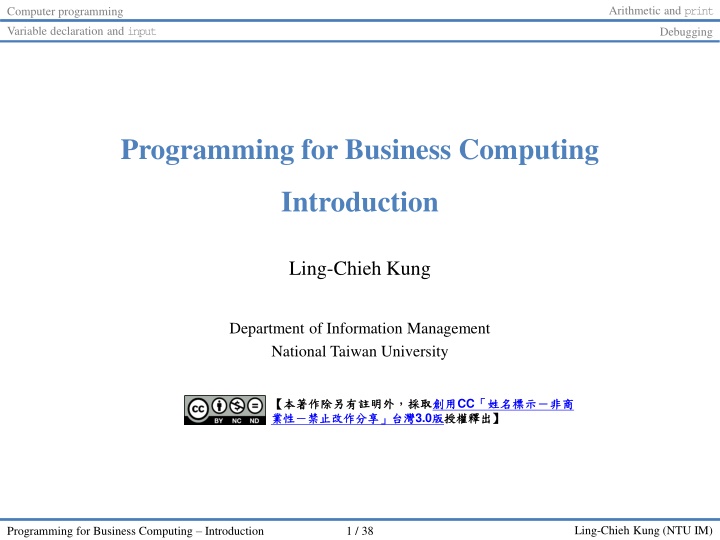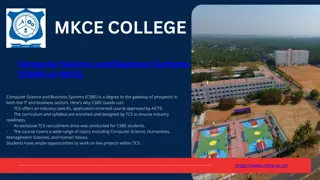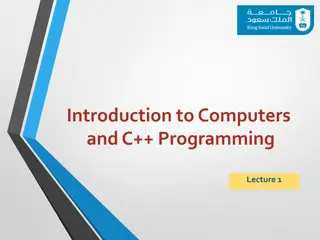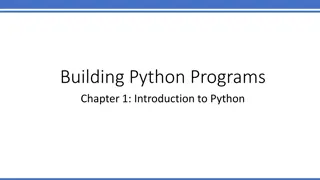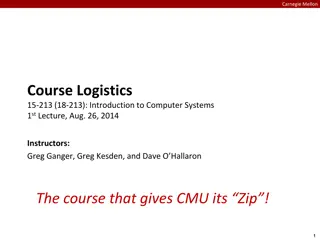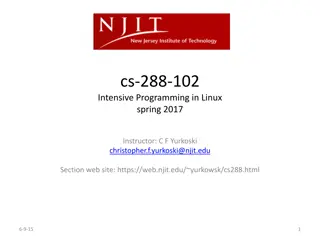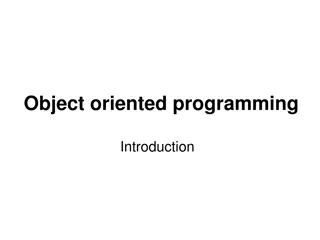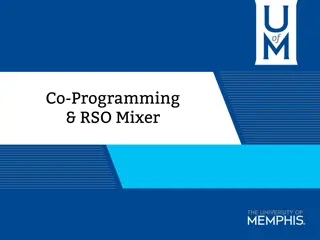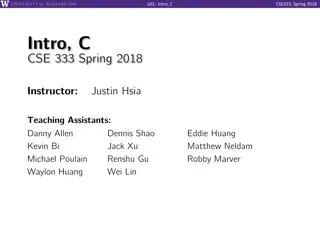Introduction to Computer Programming for Business
In this course, you will learn about computer programs, programming languages like Python, variable declaration, input processing, debugging techniques, and more. Understand the elements that make up computer programs and how programmers communicate instructions to computers. Python, a beginner-friendly language, will be used for hands-on learning. Explore the basics of programming through examples and practical exercises.
Download Presentation

Please find below an Image/Link to download the presentation.
The content on the website is provided AS IS for your information and personal use only. It may not be sold, licensed, or shared on other websites without obtaining consent from the author.If you encounter any issues during the download, it is possible that the publisher has removed the file from their server.
You are allowed to download the files provided on this website for personal or commercial use, subject to the condition that they are used lawfully. All files are the property of their respective owners.
The content on the website is provided AS IS for your information and personal use only. It may not be sold, licensed, or shared on other websites without obtaining consent from the author.
E N D
Presentation Transcript
Arithmetic and print Computer programming Variable declaration and input Debugging Programming for Business Computing Introduction Ling-Chieh Kung Department of Information Management National Taiwan University CC 3.0 Ling-Chieh Kung (NTU IM) Programming for Business Computing Introduction 1 / 38
Arithmetic and print Computer programming Variable declaration and input Debugging Outline Computer programming Our first program: arithmetic and print Our second program: variable declaration and input Debugging Ling-Chieh Kung (NTU IM) Programming for Business Computing Introduction 2 / 38
Arithmetic and print Computer programming Variable declaration and input Debugging Computer programming What are computer programs? The elements working in computers. Also known as software. A structured combination of data and instructions used to operate a computer to produce a specific result. Strength: High-speed computing, large memory, etc. Weakness: People (programmers) need to tell them what to do. How may a programmer tell a computer what to do? Programmers use programming languages to write codes line by line and construct computer programs . Running a program means executing the instructions line by line and (hopefully) achieve the programmer s goal. Ling-Chieh Kung (NTU IM) Programming for Business Computing Introduction 3 / 38
Arithmetic and print Computer programming Variable declaration and input Debugging Programming languages People and computers talk in programming languages. A programming language may be a machine language, an assembly language, or a high-level language (or something else). Machine and assembly languages: Control the hardware directly, but hard to read and program. High-level languages: Easy to read and program, but need a translator. Most application software are developed in high-level languages. The language we study in this course, Python, is a high-level language. Some others: C, C++, Basic, Quick Basic, Visual Basic, Fortran, COBOL, Pascal, Perl, Java, C#, PHP, Matlab, Objective C, R, etc. Ling-Chieh Kung (NTU IM) Programming for Business Computing Introduction 4 / 38
Arithmetic and print Computer programming Variable declaration and input Debugging Python Python was invented by Guido van Rossum around 1996: Was just something to do during the Christmas week. The latest version (in August, 2017) is 3.6.2. Python is very good for beginners. It is simple. It is easy to start. It is powerful. Ling-Chieh Kung (NTU IM) Programming for Business Computing Introduction 5 / 38
Arithmetic and print Computer programming Variable declaration and input Debugging Interpreting a program An interpreter translates programs into assembly programs. For other high-level programs, a compiler is used. Python uses an interpreter. An interpreter interpret a program line by line. We may write Python in the interactive mode. Input one line of program, then see the result. Input the next line, then see the next result. The statements should be entered after the prompt. Ling-Chieh Kung (NTU IM) Programming for Business Computing Introduction 6 / 38
Arithmetic and print Computer programming Variable declaration and input Debugging Interpreting a program We may also write Python in the script mode. Write several lines in a file (with the extension file name .py), and then interpret all the lines one by one at a single execution. A programming language using an interpreter is also called a scripting language. E.g., R. Ling-Chieh Kung (NTU IM) Programming for Business Computing Introduction 7 / 38
Arithmetic and print Computer programming Variable declaration and input Debugging How to run Python To taste Python online: https://www.python.org/ or other similar websites. To get the Python interpreter: Go to https://www.python.org/downloads/, download, double click, and then click and then click and then you are done. To try the interactive mode: Open your console (the command line environment) and type pythonto initiate the interactive mode. You may need to set up your PATH variables. Ling-Chieh Kung (NTU IM) Programming for Business Computing Introduction 8 / 38
Arithmetic and print Computer programming Variable declaration and input Debugging How to run Python To run Python on IDLE (Python GUI): Click its icon and then play with the prompt. Do File New File to write and execute a script. To write Python on an editor and interpret a script with the interpreter: Open a good text editor (e.g., Notepad++), write a script, save it (.py). Open the console, locate your script file (.py), interpret it with the instruction python, and see the result. (Figure 1.1, Think Python) Ling-Chieh Kung (NTU IM) Programming for Business Computing Introduction 9 / 38
Arithmetic and print Computer programming Variable declaration and input Debugging Outline Computer programming Our first program: arithmetic and print Our second program: variable declaration and input Debugging Ling-Chieh Kung (NTU IM) Programming for Business Computing Introduction 10 / 38
Arithmetic and print Computer programming Variable declaration and input Debugging Our first program As in most introductory computer programming courses, let s start from the Hello World example: print("Hello World!") Let s try this in the interactive mode! Ling-Chieh Kung (NTU IM) Programming for Business Computing Introduction 11 / 38
Arithmetic and print Computer programming Variable declaration and input Debugging Our first program print("Hello World!") The program has only one statement. In this statement, there is one single operation. printis a function: Print out whatever after it on the screen. "Hello World!"is an operand: A message to be printed out. In Python, each statement must be put in a single line in your editor. Ling-Chieh Kung (NTU IM) Programming for Business Computing Introduction 12 / 38
Arithmetic and print Computer programming Variable declaration and input Debugging Our first program We of course may print out other messages. print("I love programming!") It does not matter whether to use single or double quotation marks here. As long as they are paired. Ling-Chieh Kung (NTU IM) Programming for Business Computing Introduction 13 / 38
Arithmetic and print Computer programming Variable declaration and input Debugging Printing out more complicated messages What if we want to print out Something is wrong when we want to create a new line! Ling-Chieh Kung (NTU IM) Programming for Business Computing Introduction 14 / 38
Arithmetic and print Computer programming Variable declaration and input Debugging A newline character Inside a computer, everything is encoded. In particular, each character has a corresponding number representing it. Creating a new line actually means printing out a newline character . A right way to do it is: print(" \n ") That \nis the newline character. Ling-Chieh Kung (NTU IM) Programming for Business Computing Introduction 15 / 38
Arithmetic and print Computer programming Variable declaration and input Debugging Escape sequence In Python (and many modern language), the slash symbol \ starts an escape sequence (character). An escape sequence represents a special character that does not exist on the keyboard. Escape sequence \n \t Escape sequence \\ \' \" Effect Effect A slash: \ A single quotation: ' A double quotation: " A new line A horizontal tab Ling-Chieh Kung (NTU IM) Programming for Business Computing Introduction 16 / 38
Arithmetic and print Computer programming Variable declaration and input Debugging The escape sequence \n Try it: print(" \" \n \"") print(" \n ") print(' \" \n \"') More details about string operations will be discussed later in this semester. Ling-Chieh Kung (NTU IM) Programming for Business Computing Introduction 17 / 38
Arithmetic and print Computer programming Variable declaration and input Debugging Basic arithmetic Computers are good at doing computation. All computation starts from simple calculation, i.e., arithmetic. We may use the operators +, -, *, /, and //to do addition, subtraction, multiplication, floating-point division, and floor division. We may use (and ), i.e., a pair of parentheses, to determine the calculation order. We may use the operator **to find the square of a number. Ling-Chieh Kung (NTU IM) Programming for Business Computing Introduction 18 / 38
Arithmetic and print Computer programming Variable declaration and input Debugging Outline Computer programming Our first program: arithmetic and print Our second program: variable declaration and input Debugging Ling-Chieh Kung (NTU IM) Programming for Business Computing Introduction 19 / 38
Arithmetic and print Computer programming Variable declaration and input Debugging input() The printoperator prints out data to the console output. A function inputaccepts data input (by the user or other programs) from the console input (typically the keyboard). A function is a set of codes that together do a particular task. This will be explained in details later in this semester. In order to get input, we need to first prepare a container for the input data. The thing we need is a variable. When we use a single variable to receive the data, the syntax is variable = input() Let s first learn how to declare variables. Ling-Chieh Kung (NTU IM) Programming for Business Computing Introduction 20 / 38
Arithmetic and print Computer programming Variable declaration and input Debugging Variables and data types A variable is a container that stores a value. Once we declare a variable, the system allocates a memory space for it. A value may then be stored in that space. A variable has its data type. At this moment, three data types are important: int(for integer), float(for fractional numbers), and string(for strings). Three major attributes of a (typical) variable: Type. Name. Value. Ling-Chieh Kung (NTU IM) Programming for Business Computing Introduction 21 / 38
Arithmetic and print Computer programming Variable declaration and input Debugging Variable declaration Before we use a variable, we must first declare it. We need to specify its name. We need to specify its data type, initial value, or both. Typically in Python we declare a variable with an initial value directly. a = 689 b = 8.7 c = "Hi everyone, " The interpreter will automatically set the type of a variable according to the assigned initial value. To see this, put a declared variable into the function type(). Ling-Chieh Kung (NTU IM) Programming for Business Computing Introduction 22 / 38
Arithmetic and print Computer programming Variable declaration and input Debugging Variable declaration Let s try to see the types of declared variables: a = 689 b = 8.7 c = "Hi everyone, " print(type(a)) print(type(b)) print(type(c)) A variable may be overwritten: a = 689 a = 8.7 print(type(a)) Ling-Chieh Kung (NTU IM) Programming for Business Computing Introduction 23 / 38
Arithmetic and print Computer programming Variable declaration and input Debugging Variable declaration Sometimes we have no idea about an initial value. In this case, do: a = int() b = float() c = "" Try to print them out to see their initial values! Ling-Chieh Kung (NTU IM) Programming for Business Computing Introduction 24 / 38
Arithmetic and print Computer programming Variable declaration and input Debugging Our second program (in progress) This is our second program (to be completed later): num1 = 4 num2 = 13 print(num1 + num2) We first declare and initialize two integers. We then do print(num1 + num2) There are two operations here: num1 + num2 is an addition operation. The sum will be returned to the program. That returned value is then printed out. As a result, 17is displayed on the screen. Ling-Chieh Kung (NTU IM) Programming for Business Computing Introduction 25 / 38
Arithmetic and print Computer programming Variable declaration and input Debugging Our second program (in progress) What will be displayed on the screen? num1 = 4 num2 = 13 print(num1 - num2) print(num1 * num2) print(num1 // num2) print(num1 / num2) print(num1 % num2) print(num1 ** num2) Ling-Chieh Kung (NTU IM) Programming for Business Computing Introduction 26 / 38
Arithmetic and print Computer programming Variable declaration and input Debugging Our second program Now we are ready to present our second program: num1 = int() num2 = int() num1 = int(input()) num2 = int(input()) print(num1 + num2) In this example, we allow the user to enter two numbers. We declare two variables to receive the inputs. We then use the inputfunction to read input values into the variables. We then sum them up and print out the sum. Ling-Chieh Kung (NTU IM) Programming for Business Computing Introduction 27 / 38
Arithmetic and print Computer programming Variable declaration and input Debugging Our second program Alternatively: num1 = int(input()) num2 = int(input()) print(num1 + num2) The interpreter always stops when it execute the inputfunction. It stops and waits for user input. After the user input something, it reads it into the program. Ling-Chieh Kung (NTU IM) Programming for Business Computing Introduction 28 / 38
Arithmetic and print Computer programming Variable declaration and input Debugging Our second program How about this? num1 = input() num2 = input() print(num1 + num2) The return type of inputis a string! The addition operator +will concatenate two strings. That is why the intfunction is required in the right implementation. Ling-Chieh Kung (NTU IM) Programming for Business Computing Introduction 29 / 38
Arithmetic and print Computer programming Variable declaration and input Debugging Outline Computer programming Our first program: arithmetic and print Our second program: variable declaration and input Debugging Ling-Chieh Kung (NTU IM) Programming for Business Computing Introduction 30 / 38
Arithmetic and print Computer programming Variable declaration and input Debugging Syntax errors vs. logic errors A syntax error occurs when the program does not follow the standard of the programming language. num1 = int() num2 = int() num1 = int(inpnt()) num2 = int(input()) print(num1 + num2) The interpreter detects syntax errors. Ling-Chieh Kung (NTU IM) Programming for Business Computing Introduction 31 / 38
Arithmetic and print Computer programming Variable declaration and input Debugging Syntax errors vs. logic errors A logic error occurs when the program does not run as the programmer expect. num1 = int() num2 = int() num1 = int(input()) num2 = int(input()) print(num1 + num1) Programmers must detect logic errors by themselves. The process is called debugging. Ling-Chieh Kung (NTU IM) Programming for Business Computing Introduction 32 / 38
Arithmetic and print Computer programming Variable declaration and input Debugging Steps to do computer programming (The following four pages of slides are modified from the lecture notes by Professor Pangfeng Liu in NTU CSIE.) First, edit a program. Second, interpret the program. If there is a syntax error, fix it. Edit a program Interpret the program Yes Syntax error? No Ling-Chieh Kung (NTU IM) Programming for Business Computing Introduction 33 / 38
Arithmetic and print Computer programming Variable declaration and input Debugging Steps to do computer programming Next, execute the program. Be aware of runtime errors: A runtime error is one kind of logic error. When it happens, the program cannot terminate as we expect. Edit a program Interpret the program Yes Syntax error? No Execute the program Yes Runtime error? If there is a runtime error, fix it. No Ling-Chieh Kung (NTU IM) Programming for Business Computing Introduction 34 / 38
Arithmetic and print Computer programming Variable declaration and input Debugging Steps to do computer programming Now your program terminates successfully. Next, check your answer. You get a wrong answer if the outcome is incorrect. Wrong answer is one kind of logic error. If there is a wrong answer, fix it. Typically the most time consuming step. Logic! Edit a program Yes Interpret the program Syntax error? No Yes Execute the program Runtime error? Yes No Wrong answer? No Ling-Chieh Kung (NTU IM) Programming for Business Computing Introduction 35 / 38
Arithmetic and print Computer programming Variable declaration and input Debugging Steps to do computer programming Now the answer is correct. What is the next step? Write your next program! Edit a program Yes Interpret the program Syntax error? No No Yes Execute the program Runtime error? Yes No Wrong answer? Ling-Chieh Kung (NTU IM) Programming for Business Computing Introduction 36 / 38
Arithmetic and print Computer programming Variable declaration and input Debugging Using Notepad++ to run Python directly We may use Notepad++ (or many other editor) to run Python directly. To do so: Select Run Run Enter cmd /k C:/Python36/python "$(FULL_CURRENT_PATH)" & PAUSE & EXIT Select Save and choose a hotkey combination you like. Please replace the path in red by the path in your computer! Ling-Chieh Kung (NTU IM) Programming for Business Computing Introduction 37 / 38
/ Python Software Foundation, Guido van Rossum https://www.python.org/ 46 52 65 2017/7/24 visited 1 8 WordPress, Green Tea Press, Allen B. Downey, Think Python ver2.0.17,P2, CC BY-NC 3.0, 2012/8/3 http://www.greenteapress.com/thinkpython/thinkpython.pdf 2017/7/24 visited 2 9 3 16 , CC BY-NC-ND 3.0 Microsoft Office https://products.office.com/zh-tw/home 46 52 65 2017/7/24 visited 4 34 Microsoft Windows https://www.microsoft.com/zh-tw 46 52 65 2017/7/24 visited 5 34 6 1-38 , CC BY-NC-ND 3.0 Ling-Chieh Kung (NTU IM) Programming for Business Computing Introduction 38 / 38
